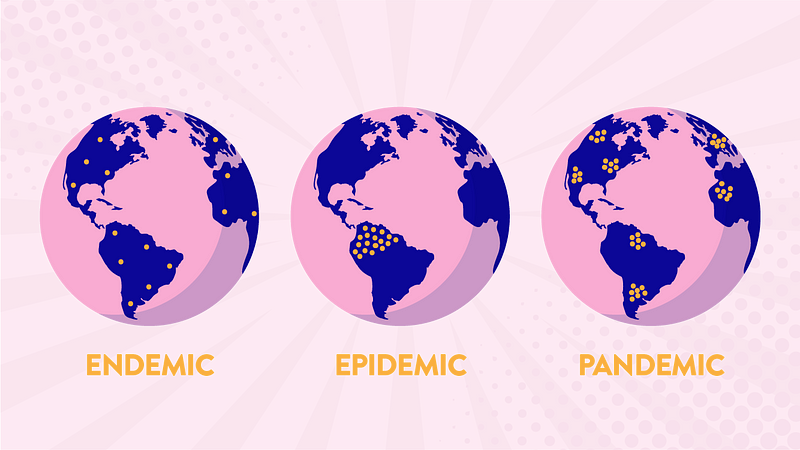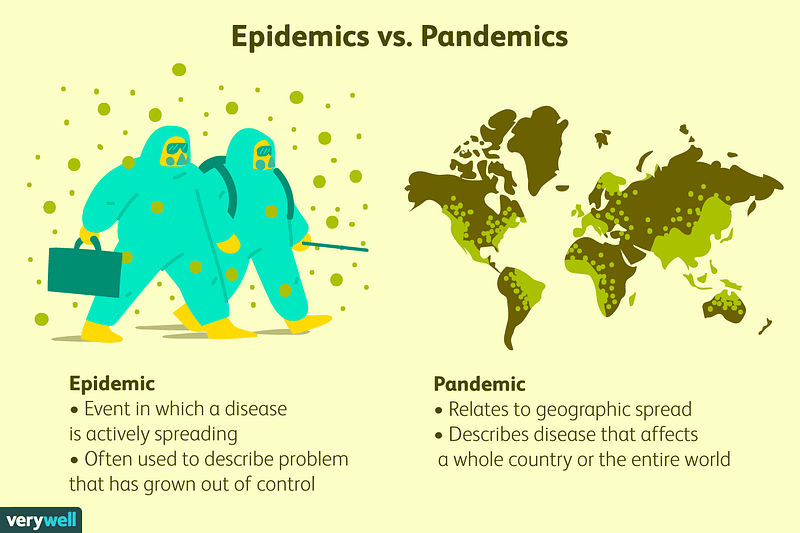Understanding the Differences Between Epidemics and Pandemics
Written on
Chapter 1: The Nature of Epidemics and Pandemics
In the face of a rapidly spreading virus, countries around the world are quick to recognize the threat it poses. The urgency to act is understandable; no nation wants to grapple with a situation where widespread illness brings societal collapse. It's important to clarify that while these scenarios can be daunting, they often refer to a pandemic rather than an epidemic. Though the two terms share similarities, they possess distinct characteristics. An epidemic typically signifies a health crisis that spirals out of control, affecting a significant population across a wide area. One of its defining traits is the abruptness with which it manifests, leading to rapid and uncontrollable spread.
A pandemic, on the other hand, represents a more severe escalation of an epidemic. It impacts an entire country or even multiple nations. If an epidemic persists and continues to spread uncontrollably, it can evolve into a pandemic. While pandemics are also challenging to manage, they may not always arise suddenly. You can think of a pandemic as a collection of numerous small epidemics occurring simultaneously.
It's worth mentioning that a global pandemic refers to a situation where the health crisis spans across multiple countries. This term essentially indicates that the problem is not confined to one geographical area but is prevalent worldwide.

Chapter 2: Understanding Pandemic Terminology
Many of the terms surrounding disease outbreaks can be confusing, but understanding them is crucial.
This video provides insights into the distinctions among epidemic, pandemic, and endemic situations in a clear manner.
When discussing infectious diseases, it's common to encounter additional terminology. For instance, sporadic cases refer to diseases that appear irregularly without a clear pattern, such as rabies or tetanus. A cluster indicates a sudden increase in cases, though the exact numbers may be unclear, often seen in diseases like cancer that arise from non-communicable factors.
Endemic diseases remain consistently present within a population, such as chickenpox among schoolchildren in the U.S. or malaria in parts of Africa. Hyperendemic refers to a situation where the prevalence of a disease is unusually high compared to surrounding areas. Holoendemic describes diseases affecting nearly all individuals in a population, like malaria in sub-Saharan Africa, where nearly every person contracts the disease within a specific timeframe, though only certain age groups exhibit symptoms.
Outbreaks are localized phenomena akin to small epidemics, often marking the beginning of larger health crises.

Chapter 3: Historical Context of Epidemics and Pandemics
Epidemics, while on a smaller scale than pandemics, have still captured significant media attention throughout history.
Some noteworthy examples include:
- The Plague of Athens (430 B.C.), which struck during wartime and resulted in approximately 100,000 deaths.
- The New York City Cholera outbreak in the mid-1800s, claiming around 150,000 lives.
- The Russian Plague (late 1700s), which caused similar devastation and social unrest.

In contrast, pandemics often receive more widespread attention due to their far-reaching effects:
- The Spanish Flu of 1918 resulted in an estimated 40-50 million deaths across Europe.
- The Black Death (1347–1351), which was responsible for around 200 million fatalities, significantly altered socio-economic structures.
- The Third Plague (1885), which affected regions between China and India, led to about 12 million deaths.

Conclusion: Key Takeaways
To summarize, epidemics occur in localized areas and typically signify an unusual surge in disease spread. In contrast, pandemics involve widespread transmission across entire countries or globally. Understanding these terms helps gauge the seriousness and speed of disease proliferation. However, it’s essential to remain vigilant, as media representations can sometimes blur the lines between these classifications.
This video elaborates on the differences between pandemics and epidemics, providing clarity on their implications.
Thank you for reading! If you wish to engage further, feel free to reach out at [email protected] or connect with me on LinkedIn. Special thanks to Vikram Menon and Sohail Mohammed for their contributions to this research!